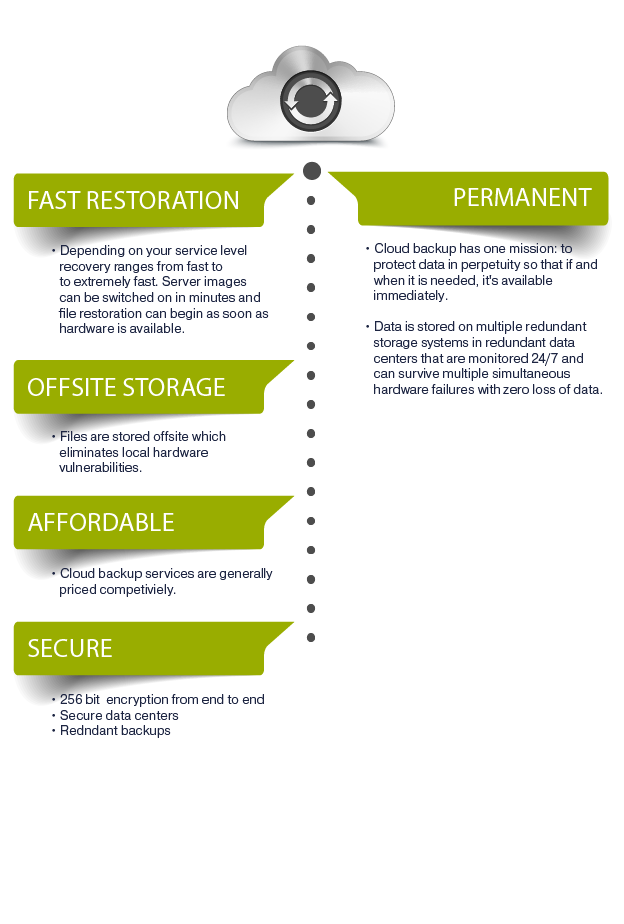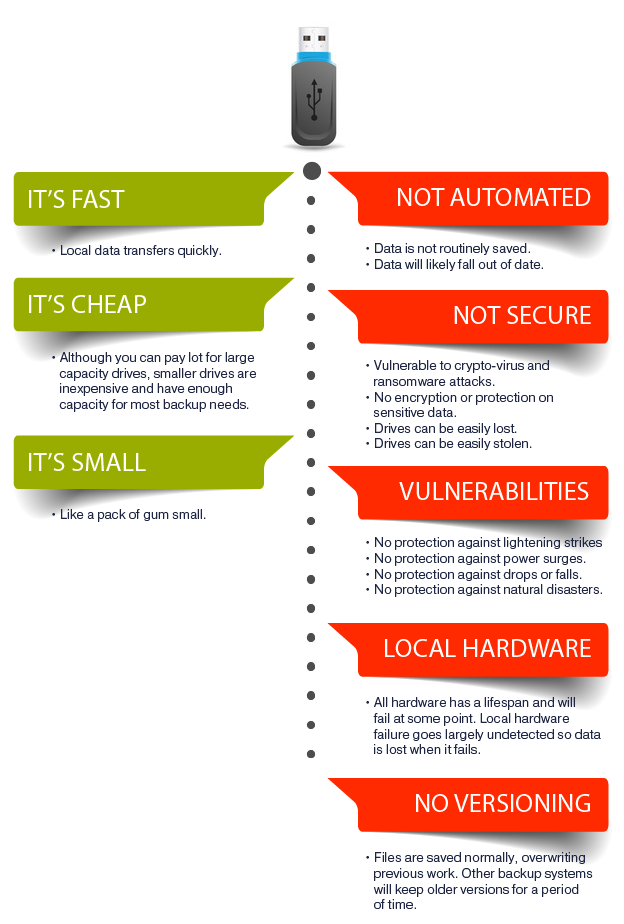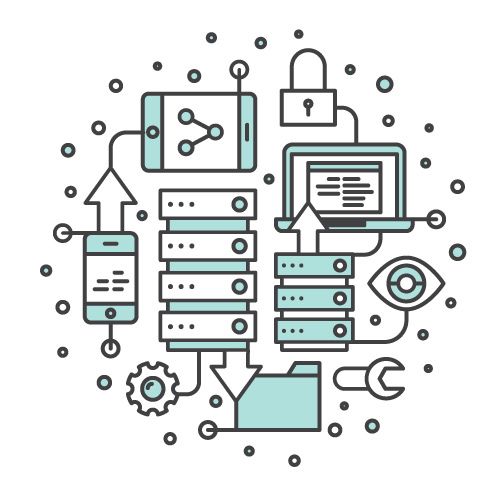
Small Business Data Backup Strategies
When a crypto-virus hits you not only lose every database, letter, logo, spread sheet, bookmark, employee record, and email—but years of decisions, collaboration, and money poured into your business. Countless hours of work are locked in plain sight, morphed into random characters with unbreakable encryption.
Paying the ransom isn’t smart, ethically or financially. Cyber-criminals are as untrustworthy as their land-based counterparts. While big business has reportedly lost hundreds of millions of dollars to the NSA’s EternalBlue exploit adopted by criminal hackers, the impact on small and medium sized business goes largely unreported and certainly underappreciated.
The only way to safely recover your data is to have it backed up. And while cloud backup checks all the boxes in terms of security, functionality, and cost, a $30 flash drive and a diligent assistant can also be your savior. To that end, we’ve put together several data protection strategies along with our honest assessment of their efficacy, reliability, and cost.
Flash/Thumb Drives
These little guys get faster and more jam packed every day. Right now, 2 terabyte drives set the limit. That’s a tremendous amount of data and enough to backup several computers, which might be your entire office. If you backed up the documents folder on each of your computers you wouldn’t regret it, even if you only did it once. I would have given my right arm for year-old backup.
There are plenty of drawbacks with flash drives. Most noteworthy, if all your data is portable it can walk out the door with an employee or thief. The drives are very small, which is a blessing and curse; they’re as easy to lose as Chapstick. So if you use this strategy be sure to store the drives in a safe place.
In this scenario, the responsibility of keeping your data backed up is yours alone. We don’t recommend it, but it can work and if you have a tight budget and it’s infinitely better than doing nothing.

External Drive Backup
Most external hard drive solutions come complete with software to automate your backup. This solution works fairly well for desktop computers. You can ‘set and forget’ backups to run overnight and they are reasonably priced. I don’t recommend for laptops for the simple reason that they’re cumbersome and unsafe to travel with.
There are several weaknesses with this strategy, however. First, they’ll suffer the same fate as your computer in a natural disaster. A lightning strike is just as likely to take out your external drive as your internal one. Since the drive connects to your computer its files will be encrypted and held for ransom in a crypto-virus attack as well. Physical security raises another concern, if a thief is jacking your computer he’s taking the drive too.
Mirrored Drives
If you can afford IT services, installing mirrored drives can almost zero out down time. Your main drive perpetually writes an exact copy to the mirrored drive. So if the main drive fails, you simply start up your computer on the mirrored drive like nothing happened. Of course, you’ll need to fix the root problem and get a new primary drive right away, but you won’t miss deadlines or disappoint clients.
Mirrored drives share the same vulnerabilities as external drives in terms of natural disasters, vulnerability to crypto-viruses, and theft.
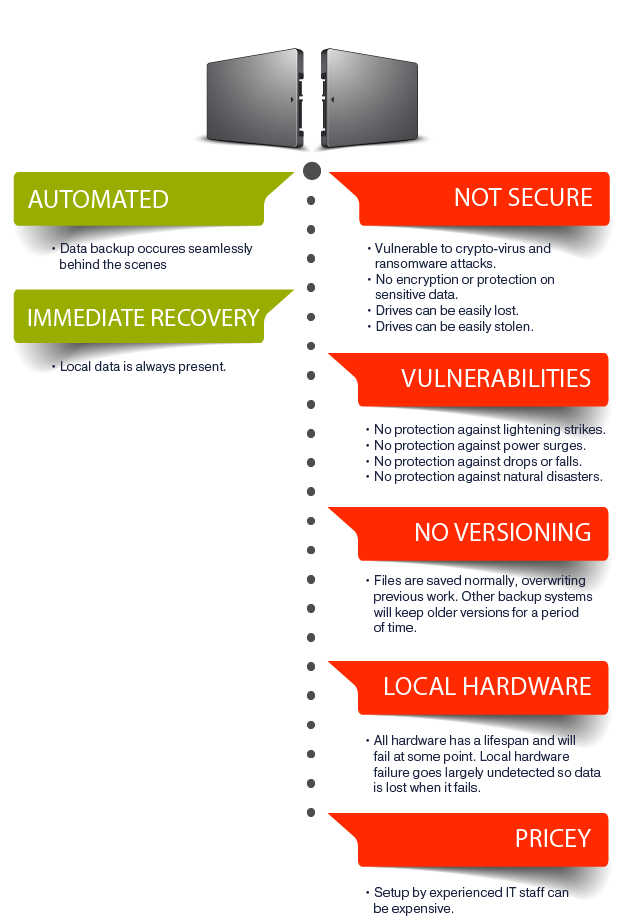
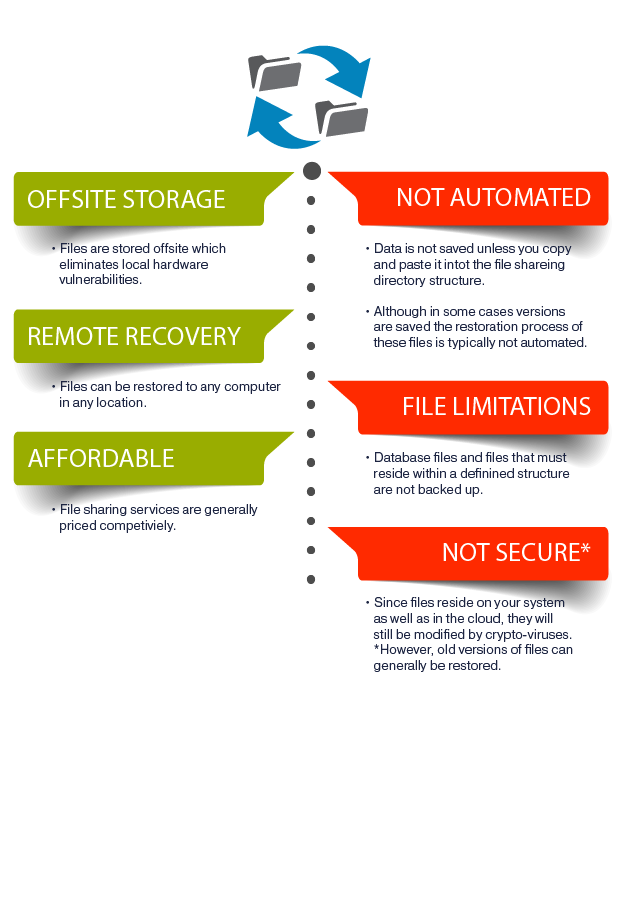
File Sharing Software (e.g. DropBox)
Services like DropBox are evolving to meet the needs of small business. Like dedicated backup services, they keep versions of your files that can be restored. I implemented DropBox as my first backup solution after our data loss. But if you’re using file sharing software for its intended use, file sharing, you’ll quickly find that your files will outgrow your hard drive. In addition, files are not backed up on a schedule and if your working files reside in a shared directory, your hard drive and bandwidth will take a bigger hit.
Cloud Backup
Cloud backup consists of client and remote systems working together to store your data offsite. This automated system runs either continuously or on a schedule you choose. When you edit files, the system saves a new version of the file to the backup system. The software securely transmits this new version to the backup server, making it recoverable for the period of time specified your agreement. Cloud storage also comes with end-to-end encryption so your data cannot be stolen in transit.
The most basic level of cloud backup saves one computer’s “Documents” folder. In this scenario, if your computer were hit with a crypto-virus, for example, files are safely stored offsite. Most Operating systems have the ability reinstall themselves quickly, wiping out the virus, and your files can be safely restored.
More robust cloud backup options include entire system image backups. Instead of reinstalling the OS, computers and servers are restored entirely to the last time good data was saved, restart and they’re up and running.
While no perfect system exists, Nordic Backup evolved over the years, guided by our mission to protect our customers from data loss. Our diligent staff, built-in warning systems, and smart client software ensure your data is always backed up and there when you need it.
